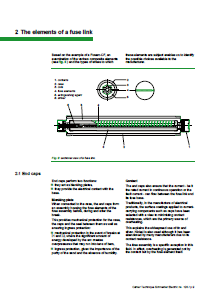Protection purpose
MV current-limiting fuses are primarily used to protect transformers, motors and other loads. There is no need to list all the advantages which make this device so successful. Its low cost and its limiting characteristics, which significantly reduce current amplitude and the energy released in the event of a shortcircuit, are among its most lauded features.
There is currently no other device on the market to rival or even come close to the performance of the fuse in medium voltage (3.6 to 36 kV) applications. However, this device does have limits which should not be exceeded. The reluctance of some users to use fuses is often due to previous bad experiences caused by a failure to follow certain basic rules of construction or use resulting in faults during operation.
It is then only after carefully considering the design requirements of a fuse link that users become aware of any rules of use, which, if observed, will ensure the fuse’s optimum faultless operation.
Basic characteristics
Standard IEC 60282-1 defines three currentlimiting fuse categories based on the type of application in which the fuse is to be used:
Associated fuse
For applications in which the improbability of low fault current values can be proven, either by means of calculation or on the basis of past experience. However, it must be ensured that the minimum rated breaking current of the fuse link is less than the minimum short-circuit current that may appear upstream of the low-voltage safety device.
General purpose fuse
If experience or calculation indicates that there may be very low overcurrents on the line (i.e. less than approximately four times the rated current of the fuse).
Integral cut-out fuse
Recommended in particular for applications in which overcurrents may be as low as the minimum fusing current and when the fuse must be derated in order to be used in a case. This “Cahier Technique” is concerned primarily with associated fuses, but also discusses concepts that are applicable to all fuse categories.
The basic definitions below can form the basis of a fuse dictionary that will facilitate discussions on the subject between fuse manufacturers, installation designers and users.
AUTHOR: Schneider Electric experts | Olivier BOUILLIEZ, Juan Carlos PEREZ QUESADA
| Title: | Design and use of MV current-limiting fuses |
| Format: | |
| Size: | 0.9MB |
| Pages: | 30 |
| Download: | Right here | Video Courses | Membership | Download Updates |


